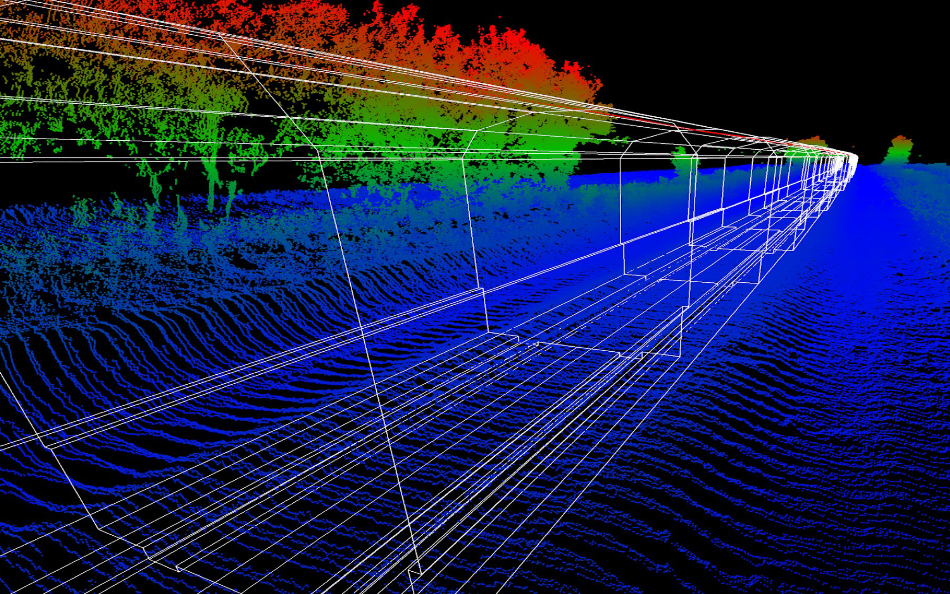Australian researchers and industry partners will collaborate to design and manufacture the world’s most precise, compact and cost-effective gyroscope, in a new $8.7 million project.
 The new ultra high-performance gyroscopes will be integrated with existing imaging systems to map the precise position of objects around rail lines, one of the many potential applications of the technology. Image from a sensor system mounted on a train.
The new ultra high-performance gyroscopes will be integrated with existing imaging systems to map the precise position of objects around rail lines, one of the many potential applications of the technology. Image from a sensor system mounted on a train.
Ultra high-performance gyroscopes can be used to improve the navigation and safety of autonomous cars, correct the course of satellites travelling at 11,000 km/h and enhance the precision of drones used for remote inspection of infrastructure.
While accurate positioning is a critical function in industries such as transport, infrastructure and space, current technical solutions are expensive, large or energy-hungry.
The new project led by navigation system manufacturer Advanced Navigation, with research partners RMIT University, The Australian National University (ANU) and commercial partner Corridor Insights, will cut the cost of ultra high-performance gyroscopes by 85%.
The project has been supported through a $2.8 million Cooperative Research Centre Projects (CRC-P) grant to Advanced Navigation, announced by Federal Minister for Industry, Science and Technology, Karen Andrews.
The CRC-P grant is enabling an $8.7 million total project investment (cash and in-kind) into delivering technology that shrinks both cost and size to enable new commercial applications that have previously never been possible.
Chris Shaw, CEO of Advanced Navigation, said the project would take groundbreaking theoretical research through to commercialisation, demonstrating Australia’s capability across the advanced manufacturing pipeline.
“This project will establish Australia as a leading manufacturer of high-performance, cost-effective navigation solutions,” Shaw said.
“Collaborating with some of our nation’s top researchers, we will be exploring the complete manufacturing pipeline - from basic microchip components, sophisticated signal processing, system integration and real-world application.
“It’s a landmark partnership that will deliver world-class technology and showcase the amazing opportunities for a new home-grown, high-tech manufacturing industry in Australia.”
High-performance navigation tech
Used to measure orientation and rotational motion, modern gyroscopes can be built with such sensitivity they are accurate to the millimetre and can detect the rotation of the Earth.
But size and cost remain the biggest challenges for wider commercial use: the price of one high-performance unit has remained about $US20,000 for a decade, while standard devices are still too bulky for easy integration into many potential applications.
To increase cost-effectiveness and reduce size, the new project brings together leading-edge optical physics from ANU with innovative photonic chips developed at RMIT.
The power of light
Inside a high-performance gyroscope is about 1km of optical fibres, wound around a spool. Laser beams inside the fibres are split in two and sent in opposite directions.
By measuring where the light reconnects, and looking at the differences in how long it takes for the light beams to travel, the gyroscope can determine position and movement with pinpoint precision.
Researchers at ANU have been adapting an optical measurement technique known as digital interferometry that can detect the tiniest of changes between the two light waves; isolating the gyroscope signal from background noise.
Concentrated and compact
Distinguished Professor Arnan Mitchell, Leader of RMIT’s Integrated Photonics and Applications Centre (InPAC), said the equipment needed to detect those changes would normally take up a large bench in a laboratory.
“The clever signal processing developed at ANU allows us to tell apart tiny signals from noise, and our photonic chip technology enables all that functionality to fit on a chip the size of a fingernail,” he said.
The photonic chips will be developed by the InPAC team at RMIT, which has leading-edge facilities for designing and printing microchips filled with light.
“By compressing the light detection technology onto a photonic chip we can shrink ultra high-performance gyroscopes from the size of a bread box to the size of a coffee cup,” Mitchell said.
ANU photonics researcher Associate Professor Jong Chow said the miniscule light inconsistencies detected through digital interferometry could have mammoth flow-on effects.
“Separating a tiny blip of noise from an actual signal can be the difference between a satellite avoiding a meteorite or crashing into it, or an automated car swerving to prevent a collision,” Chow said.
New horizons for Australian manufacturing
The global market for high performance gyroscopes in the fields of autonomous infrastructure inspection or autonomous vehicle navigation is expected to reach $US13.7 billion by 2024.
Commercial partner Corridor Insights, which develops automated hardware and software solutions that enable road, rail or energy networks to automate inspections and predict failures, will pilot and test the new gyroscopes for defect detection and management of rail networks in Australia.